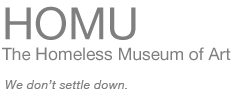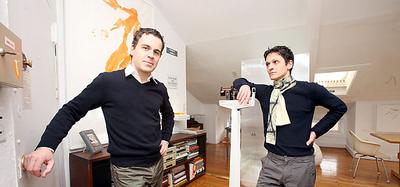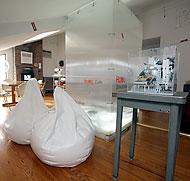
 |
| Photo: Chester Higgins Jr. |
| The New York Times January 7, 2007 Habitats | Brooklyn Heights A House Museum That's Part Serious and Part SendupBy DAN SHAWYOU may think of your home as a work of art, but you might reconsider after seeing Filip Noterdaeme's two-bedroom apartment in Brooklyn Heights. Mr. Noterdaeme has transformed every inch of his fifth-floor walk-up into the Homeless Museum, Brooklyn, a conceptual art installation known as HoMu BKLYN. "For me, the separation between art and life is nonexistent," said Mr. Noterdaeme, 41, who opens the museum once a month by invitation (info@homelessmuseum.org). These events are participatory performance art. Visitors are greeted by Mr. Noterdaeme's 36-year-old partner, Daniel Isengart, a German-born cabaret performer dressed for the occasion as Madama Butterfly. He hands each guest a Discman with the audio tour he recorded in an academic voice that sounds as if it belonged to a castrato cousin of Philippe de Montebello, the director of the Metropolitan Museum of Art. HoMu BKLYN (pronounced "Brooklyn," not B-K-L-Y-N) is an elaborate and meticulous sendup of the contemporary museum world: you feel as if you were part of a mockumentary directed by Christopher Guest of "Waiting for Guffman" and "Best in Show" fame. "We parody the language and mode of operation of other cultural institutions," said Mr. Noterdaeme, who has an insider's view, having been a gallery lecturer at both the Guggenheim Museum and the Metropolitan. All the exhibits at HoMu BKLYN remain in place when visitors leave. There is signage on every wall and doorway, so the men brush their teeth in the "Curatorial Dept.," at a sink where a sign reads "Museum Directors Must Wash Hands." They dry themselves off on towels embroidered with the orange HoMu logo. They give dinner parties for friends in the HoMu Center for Education. The museum's messages are both serious and satirical, as evidenced by the Homeless Clock, whose minute and hour hands have been switched for semiotic reasons. "When you are homeless, the hours feel like minutes and minutes feel like hours," said Mr. Noterdaeme, who professes great empathy for the plight of the homeless and has often worried that as a struggling but uncompromising artist, he might slip through the cracks and become homeless himself. "The homeless are people who have either lost everything or have given up on everything," he continued. "They're not treated like human beings but like animals on the street. How can a society as wealthy as ours allow that?" The museum raises money for the homeless with a twist on the usual cultural memberships. "We encourage visitors to become members," Mr. Isengart said. "We tell them they can choose from any levels, from $5 to $125, and that they must give the money to a homeless person of their choice directly. We do it this way so that 100 percent of their donation goes to the homeless." The museum was not originally intended to take over the couple's home. "HoMu existed on the Internet as a semifictional entity in the beginning," said Mr. Noterdaeme, who was born in Brussels and who teaches courses like "From Van Eyck to Vermeer: Masterpieces of Netherlandish Art" at New York University. The museum had a brief life at a gallery in Chelsea and in 2005 migrated to the Brooklyn Heights apartment where Mr. Noterdaeme has lived for half of his 20 years in New York. 
As the project evolved, some sacrifices were necessary. "We had to give up our living room for the Homeless Simulator," Mr. Isengart said. "At first, it was sad to have lost half our living space, but the Homeless Simulator is a really crucial piece because you realize that this is not just an apartment with art on the walls and that something else is going on here." The simulator is a translucent plastic box the size of a refrigerator carton, which visitors crawl into one at a time. Inside, there is a vintage Mixmaster with a bowl half filled with pennies. The audio tour instructs you to turn the mixer to Speed 10, which creates an unbearable racket that simulates what it must be like trying to sleep in a cardboard box under a bridge while trucks rumble by all night. Some of the pennies get sprayed around, evoking the desperate feeling of having to chase after loose coins to survive. Mr. Noterdaeme grows animated when critiquing contemporary museums. "I love museums," he said. "I am not anti-museums. But I think they have been taken over by corporatization and commercialization." When the Museum of Modern Art reopened two years ago with a new $20 admission fee, he organized a protest. He encouraged visitors to pay with 40 rolls of pennies (weighing about 12_ pounds) to show that the steep admission price was a weighty matter. "I say MoMA stands for Money Over Modern Art," he said. Mr. Isengart seconds his partner's view. "I call it the Mall of Modern Art," he said. The men claim not to have grand ambitions for their museum, which they believe would lose some of its verisimilitude if it were housed in an art gallery rather than their apartment. They wonder whether their rent-stabilized status is in jeopardy. "We're reaching the $2,000 limit," Mr. Isengart said. "The question is, Will the Homeless Museum, Brooklyn, become homeless sometime?" The couple say that the museum project, combining their personal and professional lives, has been very enriching. "It has brought us much closer, although it was always a harmonious relationship," Mr. Isengart said. "The project has become like our child." Like parenthood, the museum is a round-the-clock job. "It could be a disadvantage because we never get critical distance," Mr. Noterdaeme said. "I don't know if living here makes us better artists, but it allows for spontaneous connections to be made that would not happen if I worked in a separate studio space. It's just as much a part of us as we are a part of it." |
© 2007 The Homeless Museum. All rights reserved. homelessmuseum.org is supported by nickzilla.